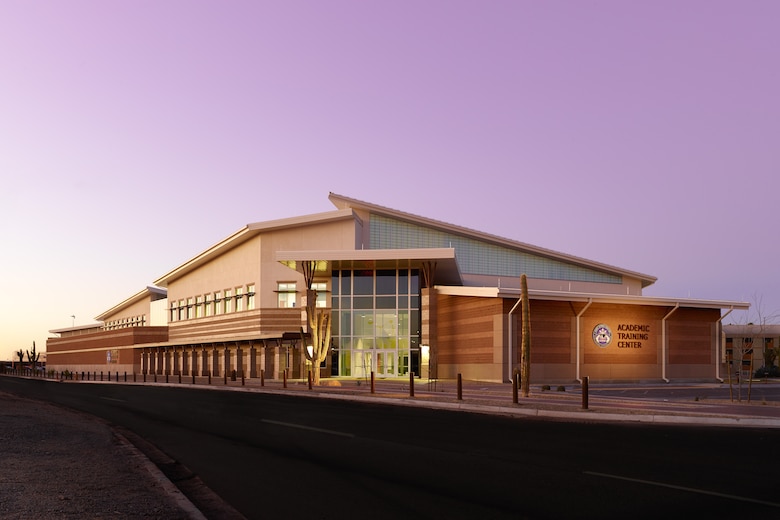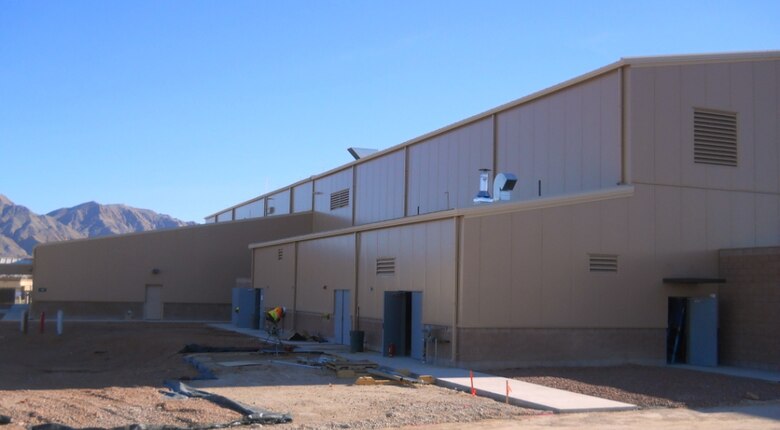The Air Force Civil Engineer Center continues a massive, multi-year construction effort to deliver the infrastructure needed to support F-35A Lightning II fighter operations at Luke Air Force Base, Arizona; Eielson AFB, Alaska; and RAF Lakenheath, United Kingdom.
From flight lines and hangars to maintenance and training facilities, AFCEC is charged with delivering the infrastructure needed to accommodate the Air Force's latest fighter aircraft, designed for new warfighting capabilities. AFCEC began "beddown" work in 2013 after the Air Force identified the destinations for the next generation fighter aircraft.
"Sustainable and right-sized infrastructure is critical to installation resiliency," said Col. Dave Norton, deputy director of AFCEC's Facility Engineering Directorate. "Our teams of engineering experts work with Air Force decision-makers to optimize infrastructure and successfully beddown new missions and airframes, like the F-35A Lightning II."
So far, AFCEC has completed the beddown programs at Nellis AFB, Nevada, and Hill AFB, Utah, and is leading multiple construction projects at Luke AFB; Eielson AFB and RAF Lakenheath.
"The Arctic region is an increasingly important strategic interest to the U.S., while RAF Lakenheath will be the first overseas location to permanently house the new F-35As," Norton said.
Luke and Nellis AFBs will provide full-spectrum training for the new high-performance aircraft, while Hill AFB, Eielson AFB and RAF Lakenheath conduct operational missions with the new airframe.
In Arizona
The $268 million investment in beddown at Luke AFB established the base as one of the largest F-35A training centers for both domestic and foreign pilots, ensuring the installation can deliver combat-ready aircrews where and when they're needed.
"Out of planned beddown at Luke AFB, we have $48 million in construction left to award, consisting of two projects," said Tom Hodges, AFCEC's Mobility Support Branch chief.
The investment is a critical requirement for additional training and maintenance facilities in preparation for a new squadron's arrival in November 2025.
"The remaining projects will support operations of a sixth squadron of F-35As and we're working with our partners to award the projects by mid 2022," said Howard Steck, AFCEC's program manager for Luke AFB.
The new infrastructure, scheduled for completion by 2025, will provide a 26,000 square-foot, state-of-the-art center for aircraft repair and maintenance and a 42,000 square-foot F-35A squadron operations facility with a dedicated area for flight planning, aircrew briefings, squadron training and administration.
In Alaska
The $667 million construction work at Eielson AFB, located east of Fairbanks, will increase air power in the Arctic.
The collaborative effort began in 2015 and brought together teams from AFCEC, the Air Force Installation and Mission Support Center's Detachment 2, the 354th Civil Engineer Squadron and U.S. Army Corps of Engineers Alaska District.
"The arctic climate creates challenges for design and construction of sustainable infrastructure," Hodges said. "We've worked closely with our mission partners to successfully accomplish a large number of projects and ensure the installation was ready for the arrival of the first F-35s in April 2020."
The program at Eielson AFB includes new construction and upgrades to existing infrastructure, all in different execution phases.
"The effort is of critical importance to the installation and requires a lot of teamwork and effective planning because of the number of projects and multiple contractors involved in each of the construction phases," said Jennifer Campbell, military construction project manager for AFIMSC's Det. 2.
Right-sized and sustainable infrastructure will allow the installation to accommodate active duty personnel relocating to Eielson to train and maintain the new aircraft.
So far, AFCEC, through AFIMSC's Det. 2, has completed $481 million of new facility construction, consisting of 15 projects to include a new F-35 flight simulator facility, a field training facility, and maintenance and shelter hangars, in addition to missile maintenance and munitions storage facilities. Additionally, two projects worth $24 million are in construction and expected to be complete by the end of the year, and two more worth $36 million are on the horizon for award before the end of September 2021.
"The projects are unique in development, currently in a final design phase to support the systems and the F-35A mission," Campbell said. They include a facility for equipment maintenance and storage, an outdoor combat arms training and maintenance range to support F-35A operations and renovation of a munition's inspection building for blast protection.
In the United Kingdom
The arrival of the F-35As at RAF Lakenheath's 48th Fighter Wing has been a long-awaited milestone for the Air Force, necessitating the need for new infrastructure.
The installation, home to the largest fighter wing in U.S. Air Forces in Europe and Air Forces Africa, is a critical component in training and combat readiness in Europe.
The beddown effort will support the 48th Fighter Wing's two F-35A squadrons operations and training.
The investment, which began in 2018, is a joint partnership between AFCEC, AFIMSC's Detachment 4, USAFE and the United Kingdom's Defence Infrastructure Organization to deliver the highest quality infrastructure to accommodate the future F-35A's mission.
In addition to extensive upgrades to the airfield, key developments include a new F-35A flight simulator, modern hangars and storage facilities to accommodate the new squadrons.

The F-35 Academic Training Center on Luke AFB, Ariz., is part of the Air Force Civil Engineer Center's multi-year construction effort to deliver the infrastructure needed to support F-35A Lightning II fighter operations. (U.S. Air Force photo)

This fuel cell hangar at Nellis Air Force Base, Nev., is part of the Air Force Civil Engineer Center's multi-year construction effort to deliver the infrastructure needed to support F-35A Lightning II fighter operations. (U.S. Air Force photo)

The F-35 Lightning II fighter jet is shown at Hill Air Force Base, Utah. The Air Force Civil Engineer Center continues a massive, multi-year construction effort to deliver the infrastructure needed to support F-35A Lightning II fighter operations. (U.S. Air Force photo by Susan Lawson)






